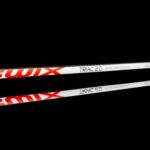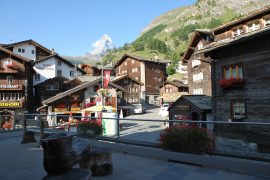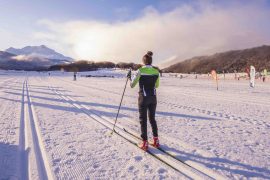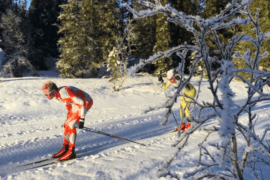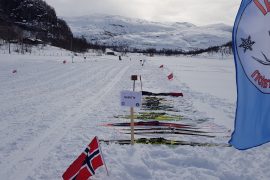Reaching far into november still the outside world hasn´t become white, at least in northern Europe and Scandianvia. When it does is highly uncertain. So far, the most certain thing to report is that cross country producer Fischer are introducing lots of exciting news this winter. They are here now – and the weather doesn´t matter any more
To a cross country (marathon) skier it´s probably the introduction of Fischer´s skin grip concept that arises most enthusiasm. As XC-marathon.com has looked at earlier, other producers have already introduced skin grip technology. This year Fischer are introducing their version. And besides another family member of their cross country line of skis, Fischer are also introducing other more or less exciting features and news.
But first let´s take a look at Fischer´s skin grip technology.
The image above shows all the three wax free technologies from Fischer beside a traditional classic wax cross country ski. Number 2 frem left; Fischer Crown, – Zero, – Twin Skin. (Click on the image for better detailed view) . The zero skis and especially Crown has been around for some years now, while the skin skis (far right; the black parallell tracks below the text «Twin Skin»are the actual skins) are new.
So let´s take a look at them.
According to Fischer, there are two advantages compared with its two brothers – or sisters. Firstly, they are regarded as the best option for hard icy tracks in freezing temperatures and coarse snow, and secondly it is precisely the grip abilities by the skin technology to the snow) is given some extra priority over gliding performance compared with zero skis. But that does not mean that skin skis are best on only coarse snow and cold. As long as it is used in fixed/prepared tracks and transformed snow (eg freezing temperatures at night), and/or hotter / mild conditions throughout the day skin- skis will work very good. When it comes to weight different skin skis from different manufacturers vary regarding deviations from a «normal» wax ski. Fischer’s skin ski have a relatively small deviation of about 100 g from the heaviest wax ski and about 200 g deviation from the lightest. Thus, weight should not bother you in any way if you choose these skis. The skin is treated with teflon from the factory and are 100% mohair (ie goat hair). Fischer recommends using zero spray on the skins over time to preserve the adhesion properties / avoid icing in the same way as with Zero skis. The skins can be replaced when they are worn out. The procedure, according to Fishcer, is easy by just heating the skin, removing it and gluing on a new. You can not switch skins before / during your exercise to change grip on the snow. Conversely skis equipped with the NIS binding plate lets you easily move the binding and adjust the arch span and thus grip during the tour (PS: Fischers new Pro Classic binding lets you do this in the simplest way).

So, when and where do I apply the new skin skis, Alf Roger Holme, Head of Marketing at Fischer Norway; If I want only one additional pair of skis to my waxable skis; is there any rule for which technology I should choose, or is my geographical whereabout and thus snow and weather conditions just as important? What about skills and ambitions? -Correct, it has a lot to do with snow conditions, skills and ambitions. In general we can say that waxable skis should be your first pair of racing, then there are zero skis as an important addition to around 0 degrees celcius snow conditions. Otherwise Crown could be the safest choice regarding grip and Skin will probably glide better in some conditions compared with the Crown.
Is it correctly understood that you recommend both Skin and RCS Crown as a satisfactory alternative to both training and races for a cross country competition (given relevant factors ) ? -These skis are probably most used for exercise, because there is little doubt that if you have waxable skis they will be better in most circumstances. The exception is the particularly difficult and particularly changing conditions.
You have different solutions for complicated conditions ( and not to mention those who want to save time in advance and drop the waxing job) but this applies primarily to questions regarding grip, or are the gliding capabilities of the Crown as good as skin skis? And are gliding properties for both Crown and skin skis as good as traditional waxable skis? -Correct, This applies primarily to grip. Gliding characteristics vary according to the specific track conditions and particularly pick or choice of skis. In most circumstances, well waxed skis glide better than Crown and skin.
If you want good grip when exercising ( and accept sacrifice a little gliding speed) you should therefore, beside the technical factors of the ski, also think about where you live and the typical snow conditions there. See also the illustration below (from Fischer ) showing the three different technologies and their recommended application regarding the weather/snow conditions.

Fischer other news include boots with a new membrane, new boot model adapted to women, even lighter and stiffer poles and not least a new production method for top skis Speedmax :

The Speedmax skis are the skis that you maybe usually see on TV and perhaps less around you in the tracks. It is the skis that the stars place beside them in front of the TV lens when interviewed after the race (even though they may not have used exactly the skis, but that’s another story). The skis have a carbon core for the lightest possible weight and best grip / gliding balance (the skis should feel soft, light to «carry» but still easy to kick down to the ground – while maintaining stiffness and a good gliding surface when the ski is gliding). The soles are of course the best Fischer has to offer regarding gliding properties. And it´s exactly the sole that is this year’s novelty. We´ll let Fischer explain: -Speedmax skis are produced with Cold Base Bonding, which means that the sole is glued on afterwards without pressure or heat. This optimizes the sole to easier take up the wax and you will get faster and greater momentum on your skis. In addition, the glue used is somewhat elastic which makes the skis preserve its properties regardless of temperature, says Alf Roger Holme at Fischer.
Do the Speedmax Zero + ski have any different characteristics from Fischers original Zero skis ? -If we compare the two racing skis that are applied with Zero + – coatings it is used the same type of coating , but Speedmax Zero + is produced with AirCore HM Carbon Core and Cold Base Bonding. RCS Zero + has AirCore Carbon core, but the same construction as Speedmax , ie 902.
Regarding Speedmax Skate Plus skis the Fischer product brochure mentions «loose conditions/surface»: Is it possible to say specifically what you consider to be loose surfaces? Is it for instance after a slope machine has made skating tracks, or is it more related to new snow / powder, possibly snow consistency ? -«Loose conditions» can for instance be when it is newly prepared by machines or heavily trodden tracks. The point is that the skis should float better with less pressure, especially in front. This also avoid the skier to » dig » too easily into the snow at the loose surface.
The brochure from Fischer focuses much on the 610 and 902 construction. For the regular reader / exerciser it is not too explanatory in itself, what is the difference? -610 construction = Skate and 902 construction = Classic, both constructions provide ski with little pressure or gap in front and tails.
Fischer is also introducing new pole models this year, for regular cross country exercisers it looks to me that it poles with different degree of content of carbon: Would you describe Air Carbon UHM as something other than Air Carbon? What is UHM abbreviation for and what kind of benefits does it provide? -UHM = Ultra High Modulus. The advantage is that this is the carbon of higher quality so that the poles can be made lighter and stiffer. There are different degrees of UHM. Speedmax has UHM 5.4 which is the highest degree in Fischers series .

How are the Speed and Quick -fit straps covered in this year’s brochure easy to take on and off ? Is there an opening and closing mechanism that makes it possible to remove the pole from my hand but keep the strap on, or is it the «regular» Velcro mechanism we talk about here (I think myself this is very relevant, because it is very difficult to deal with all possible kinds of small items in my hand with racing poles on)? -There Is no open and locking mechanism that enables you to remove the strap from the pole easily, but it is essentially the QF- strap that is the easier to put on and off due to the zipper system. A simple zipper lets you open and closed easily when you put the strap on and take it off your hand. Speed-strap work as easy as possible and does not have this zipper system, but are still relatively easy to put on and take off with the Velcro system.
Fischer also introduces a separate model for women, Motion Wax My Style; is this ski, designed specifically for women, a model you ‘d recommend to use in races / for training purposes? -This is the women’s edition of the Super Lite which is one of our best touring skis. It has a racing sole and AirCore core. Developed with a slightly different tension curve and custom design for ladies, it can be used for training and maybe skiing competitions ( such as the Birkebeiner) , but this is a ski that is not designed for the highest possible speed, but intended for touring with a considerable side cut and slightly shorter lengths, and will be stable and easy to walk on.

Finally, what about the boots, what is the most interesting news when it comes to this year’s shoes, for example RC7 Skating? What is important for a XC-marathon skier to know about these? -The Biggest news on RC7 Skating is that it has now Triple-F Membrane for a warm, dry and ventilated shoes. It is somewhat easier and have many of the same great racing properties at Carbon Lite shoes (Xcelerator sole).
Fischer has a very wide range of equipment for cross-country and marathon skiing, perhaps too wide, some would say. It can be easy to get lost in the jungle of sole alternatives, temperature conditions, styles, etc. In this article turrenn.net have looked at the most exciting innovations seen from a XC-marathon and training perspective. However, there are several models and options than what is presented here, and many of these will also work just brilliant for your needs. To find the equipment that suits you the most is our recommendation to ask the store, discuss in the forums here at turrenn.net or use the product guide that Fischer offers on its homepage.




